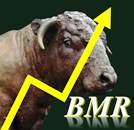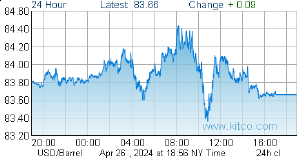From Rouyn-Noranda, Quebec, 10 pm eastern
Today I was blessed with my third visit to Gold Bullion Development’s (GBB, TSX-V) Granada Gold Property in six months. And it was terrific. Most people’s idea of excitement certainly doesn’t include visiting a dusty gold property 3,000 kilometres away in northwestern Quebec where a British Columbian can sometimes find it frustrating even ordering a Subway sandwich if all they speak is English. In all seriousness, though, BullMarketRun readers – most of whom are gold enthusiasts and intensely follow the speculative junior resource market – should certainly appreciate how intriguing it is to “hang out” along the “Cadillac Trend” and see a potential multi-million ounce gold deposit in the early stages of development.
The very first thing I noticed that was different today from previous visits was the beefed up security at the entrance to the Granada Property. Of course with all the activity here now – and there’s a lot of it – and with all the core now being logged and split on site, it just makes sense to guard the gates 24/7 (“Fort” Granada!) which is what Gold Bullion is doing through a local security company. The stakes are high and this story is garnering a lot of attention. Security and safety issues are therefore critical, and Gold Bullion has definitely stepped up to the plate in these areas. This is good to see and another sign that this is a maturing exploration company that means business.
Drill core pictures were not allowed and technicians’, geologists’ and drillers’ lips were sealed in terms of any discussion surrounding Phase 2 drilling beyond what has been released publicly by Gold Bullion. But the mood on the property is very upbeat and if body language is any indication, it’s clear to me that everyone on the Granada Property understands how big this project is and the immense potential of it. This is a focused and excited crew, a reflection of the disciplined efforts of Gold Bullion and GENIVAR, its geological consultant.
One member of the crew is Nathan Jourdain, the very energetic and highly regarded 22 year-old technician recruited late last year by GENIVAR’s Nicole Rioux who is in charge of exploration at Granada. Jourdain, who honed his skills with Agnico-Eagle, Aurizon and Richmont from 2006 through 2009 while studying geology at Rouyn-Noranda’s Cegep de l’Abitibi-Temiscamingue (he just recently graduated), has been described as a “fantastic find” and has played an important role in the success of Gold Bullion’s Phase 1 and Phase 2 drill programs. He’s eager and hungry to help find a major gold deposit. “What I like about this,” Nathan told us today, “is that it’s a big project and I’ve been involved since the first hole was drilled last December.” He’s not a shareholder in Gold Bullion (GENIVAR’s tight regulations) but he has taken ownership in different ways. He regularly puts in a 60-hour+ week and is on call 24/7, sometimes having to get out of bed to rush to the property at 2 am if something unusual develops on the drilling front. He helps coordinate a lot of activity on site and of course works frequently with maps and software to get the best understanding possible of the structures GENIVAR is finding. He has played a key role in selecting some of the drill targets and is fascinated by the “magic” of the “Cadillac Trend”. Nathan is “pumped” and that’s a good sign.

A few members of the GENIVAR/Gold Bullion team at Granada (left to right, Marie, Charles, Nathan and Aliou). This picture was taken in the eastern extension area - Gold Bullion is using crushed rock from the waste pile to build a good road leading out to LONG Bars Zone 2.
The Cadillac Fault, a regional structure that traverses through the northern edge of Gold Bullion’s claims, has indeed been the driving force, geologically, at Granada. The Fault runs one kilometre deep and is spatially related to numerous multi-million ounce deposits including of course Osisko’s massive Canadian Malartic Deposit 65 kilometres to the east. I’m not a geologist, but I’ve studied Granada intensely beginning more than a month before BMR first introduced Gold Bullion to its readers when the stock was sitting at just 7 cents last December. I’ve spoken to numerous geologists regarding Granada and the “Cadillac Trend” in general. Gold Bullion is searching for gold in one of the most highly prospective areas there is anywhere.
There is no denying that the LONG Bars Zone has the potential to develop into a multi-million ounce open-pit deposit. Much deeper down, given the nature of the Cadillac Trend, this property also has potential as a high grade underground operation. We’ve stated this before and it’s worth stating again – the best place to find a new mine is often near an old mine. Granada produced 50,000 ounces of gold in the 1930’s and 80 years later Gold Bullion’s fresh approach to this former mine, and the nearly 5,000 hectare land package surrounding it, is starting to pay big dividends.
North of the Cadillac Fault, where one sees much more VMS-style mineralization, are volcanic rocks. Sedimentary rocks are found south of the Fault where there tends to be considerably more faulting, increasing the chances of gold mineralization (many secondary faults have developed from the Cadillac Fault). Based on historical information and what has been reported so far by Gold Bullion, there is intense faulting and alteration throughout Granada. One of the keys for GENIVAR, in our view, is identifying the location, dip and depth of these faults and chances are they have had success in doing that based on the highly encouraging news Gold Bullion issued July 13 and July 29.
Infill drilling continues within the Preliminary Block Model where Gold Bullion outlined a potential non-compliant resource of 2.4 to 2.6 million ounces in late April. Holes 33 and 41, released July 29, show the Block Model is on track but tighter spacing and much more drilling are still ahead. Additional potential exists at depth. Keep in mind, also, that this and other areas at Granada are renowned for particle gold that in many cases won’t show up in drill results but will be processed in the mining procedure – the so-called “upgrading” effect that has certainly been seen elsewhere. That’s why Gold Bullion’s large 2007 bulk sample (grading 1.62 g/t Au) was so important.
East of the Preliminary Block Model is where things get really interesting as this huge area has “blue sky potential” written all over it. Historically, the Granada “eastern extension” has been under-explored but there is enough information – historical and current – to suggest there could be widespread, near-surface mineralization in this area through, in part at least, quartz veining and gold that is carried in disseminated sulphides in feldspar porphyry. A very large low grade “halo” effect could also exist here – in terms of its total mineralized surface area, the eastern extension could eventually dwarf the size of the current Preliminary Block Model. If a lot of nice intersections of around a gram or better start coming in from the east, it will be “mission accomplished” for Phase 2. And it wouldn’t be surprising to see a few spectacular holes based on the visuals.
As Gold Bullion reported July 29, “Each and every hole (north, south, east and west of GR-10-17)” has intersected “significant zones of altered feldspar porphyry (favorable for gold mineralization) with quartz veining. Visible gold has also been observed in many of these holes including GR-10-78 which just became the easternmost hole drilled to date by Gold Bullion at Granada. GR-10-78, collared nearly 250 metres east of GR-10-17, was drilled to a vertical depth of 350 metres and intersected large alteration and intrusive zones.”
Gold Bullion appears to be encountering much more altered feldspar porphyry in the eastern extension. Upcoming drill results from the east and extensive analysis by GENIVAR should give us a better understanding of what is really going on in this part of the LONG Bars Zone. An interesting observation is made on page 88 of Willoughby’s 1994 report (“Geology, Structure and Gold Mineralization on the Granada Extension Property”) that we obtained through the Quebec Ministry of Mines a couple of months ago. “Sulphides (mainly pyrite) are abundant in porphyry on East Granada, in the area of the Aukeko Shaft.” Are they abundant in porphyry elsewhere as well?
Willoughby made numerous important observations regarding Granada in general in his 1994 report:
“A large circular feature interpreted from air photos encloses most of the Granada Mine Property and suggests an intrusive stock at depth, perhaps the feeder for the numerous sills and dykes mapped at surface.”
“The role of major northeasterly fault structures in the localization of high-grade zones as steeply dipping, northeast plunging ore bodies is considered significant.”
“The area of shearing and alteration covering the gold veins/structures on the Granada Mine Property (what Gold Bullion is currently drilling) comprise a relatively distinct zone measuring some 450 metres wide and 2 km long. Previously designated the Mine Sequence…regional consideration and 1994 mapping results show the zone continues both east and west, attaining truly regional dimension.”
“The ongoing mapping and drilling of the Granada Mine and Granada Extension properties indicate an 8 km long zone of shearing, deformation and gold mineralization along the southern part of the Granada Segment, and in conjunction with other mineralization features apparent within the segment, is considered to be a regional feature.”
Oh, and we certainly shouldn’t forget about Big Bert in LONG Bars Zone 2. As exciting as our visit was today, the golden highway hasn’t quite been completed out to that area yet so unfortunately we weren’t able to pay a visit. Of course we’re referring to the Bert Vein near the old Aukeko shaft. The average assay of three bulk samples (reported in 1938 by Hosking, according to Willoughby’s report) was 7 ounces Au per tonne. Gold Bullion plans to visit Big Bert later this year as exploration moves further east at Granada.
With a strong team on the ground as we saw today at Granada, working a highly prospective and big project, there’s no question Gold Bullion Development has a golden opportunity on its hands.
 BullMarketRun.com
BullMarketRun.com









Very nice report and well written. Enjoyed the quotes from Willoughby’s 1994 report in particular.
Comment by Michael — August 25, 2010 @ 8:12 pm
Great report, great story unfolding, with hopefully a great ending. Tks.
Comment by ralph — August 26, 2010 @ 1:42 am